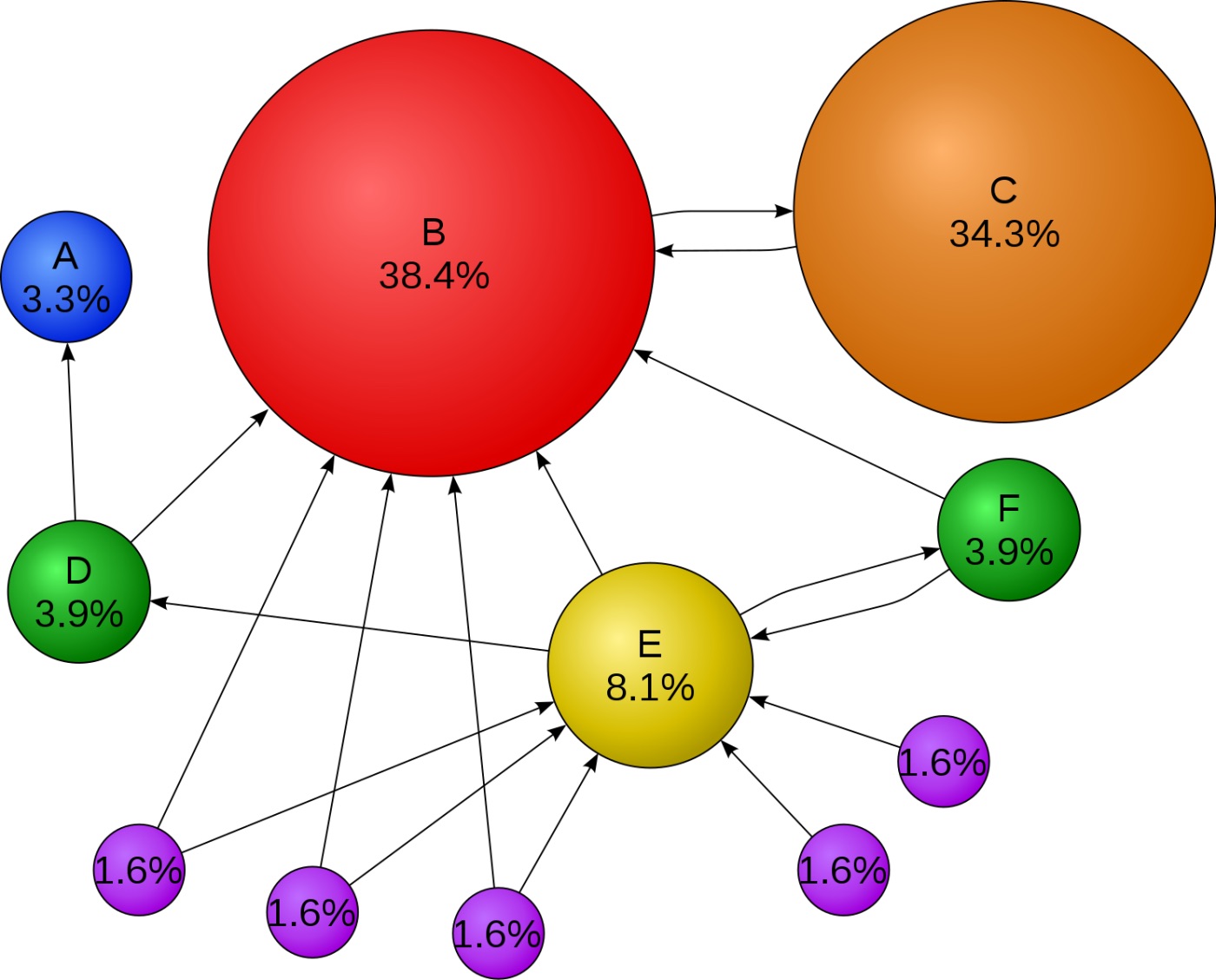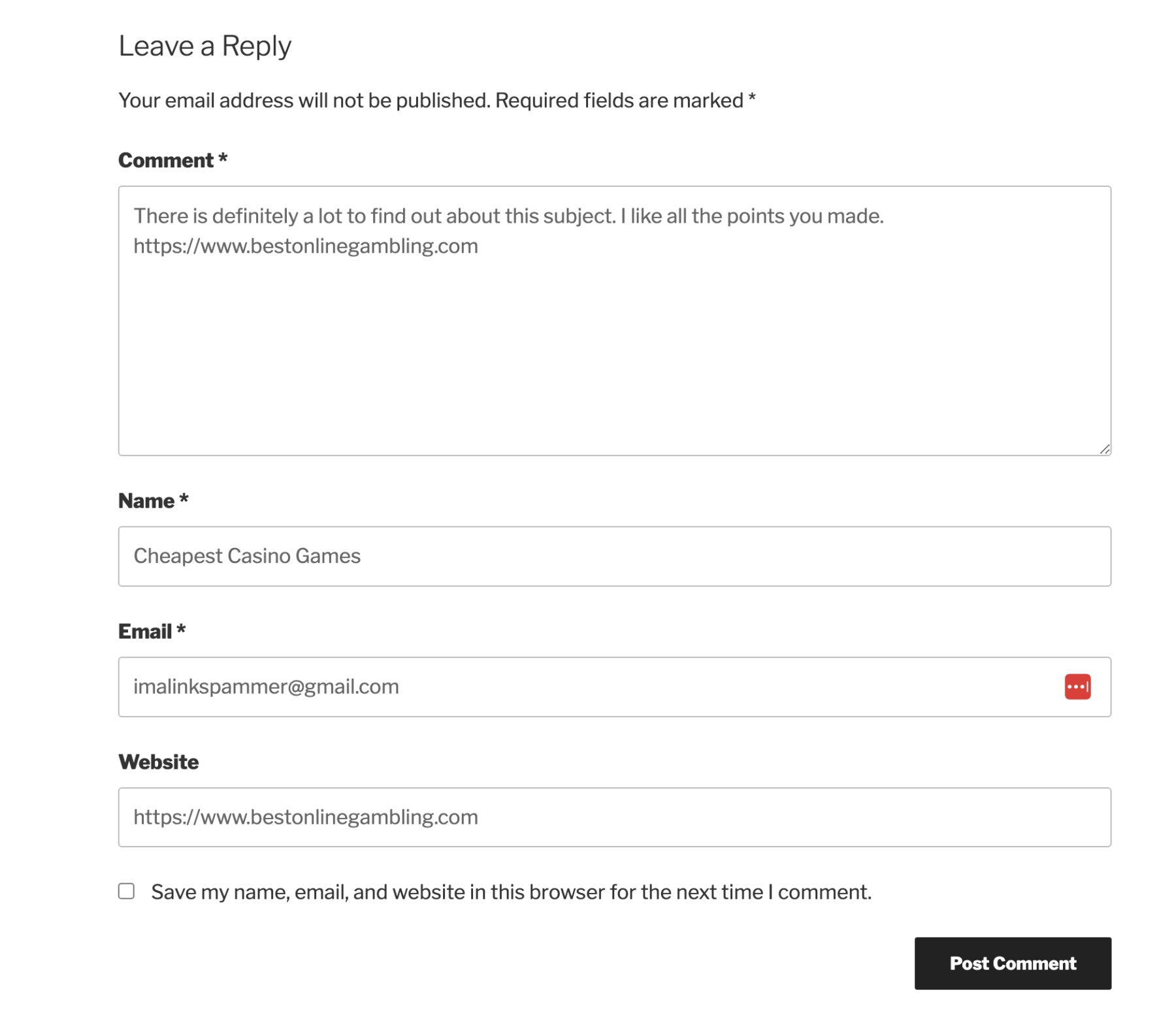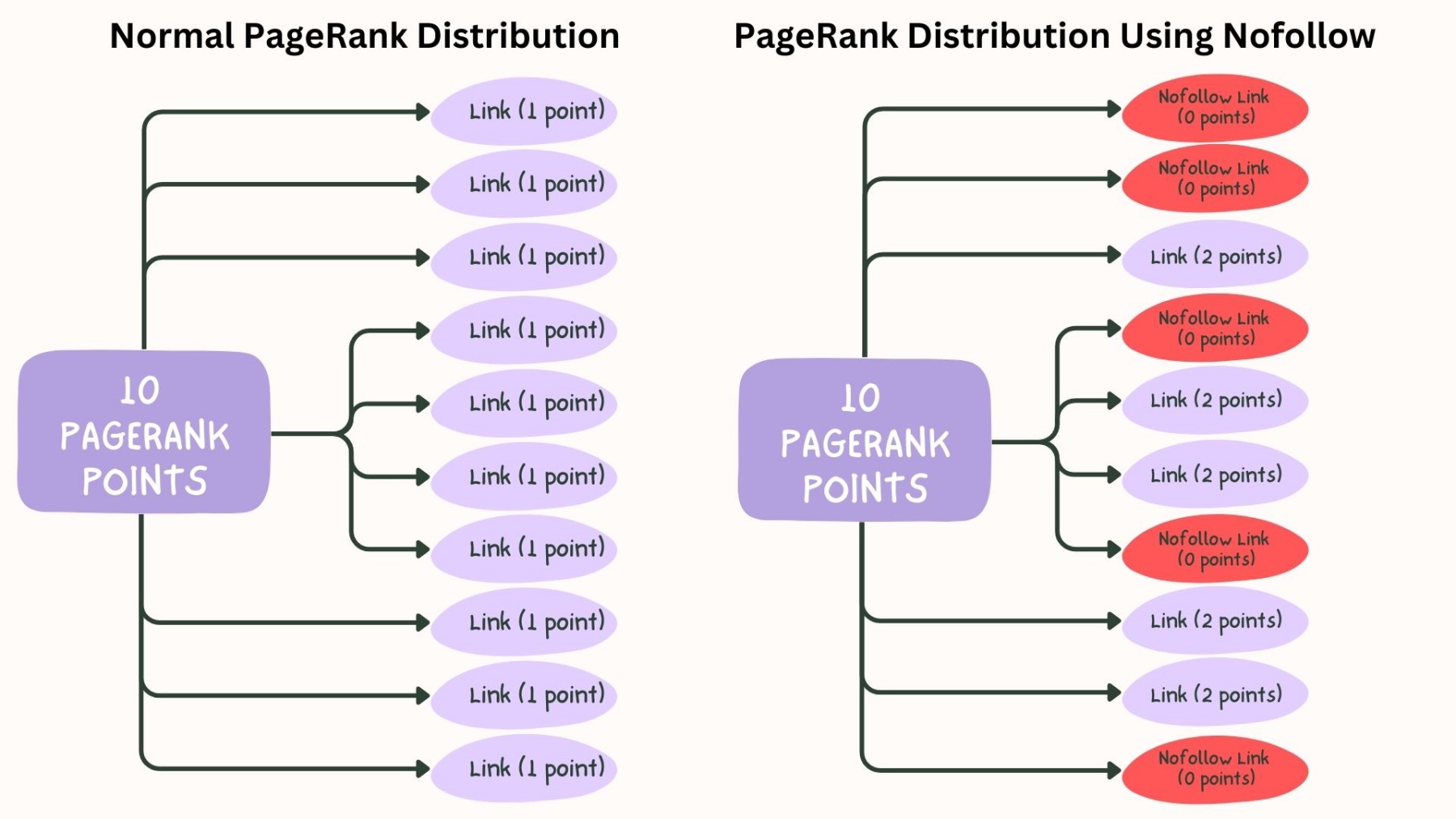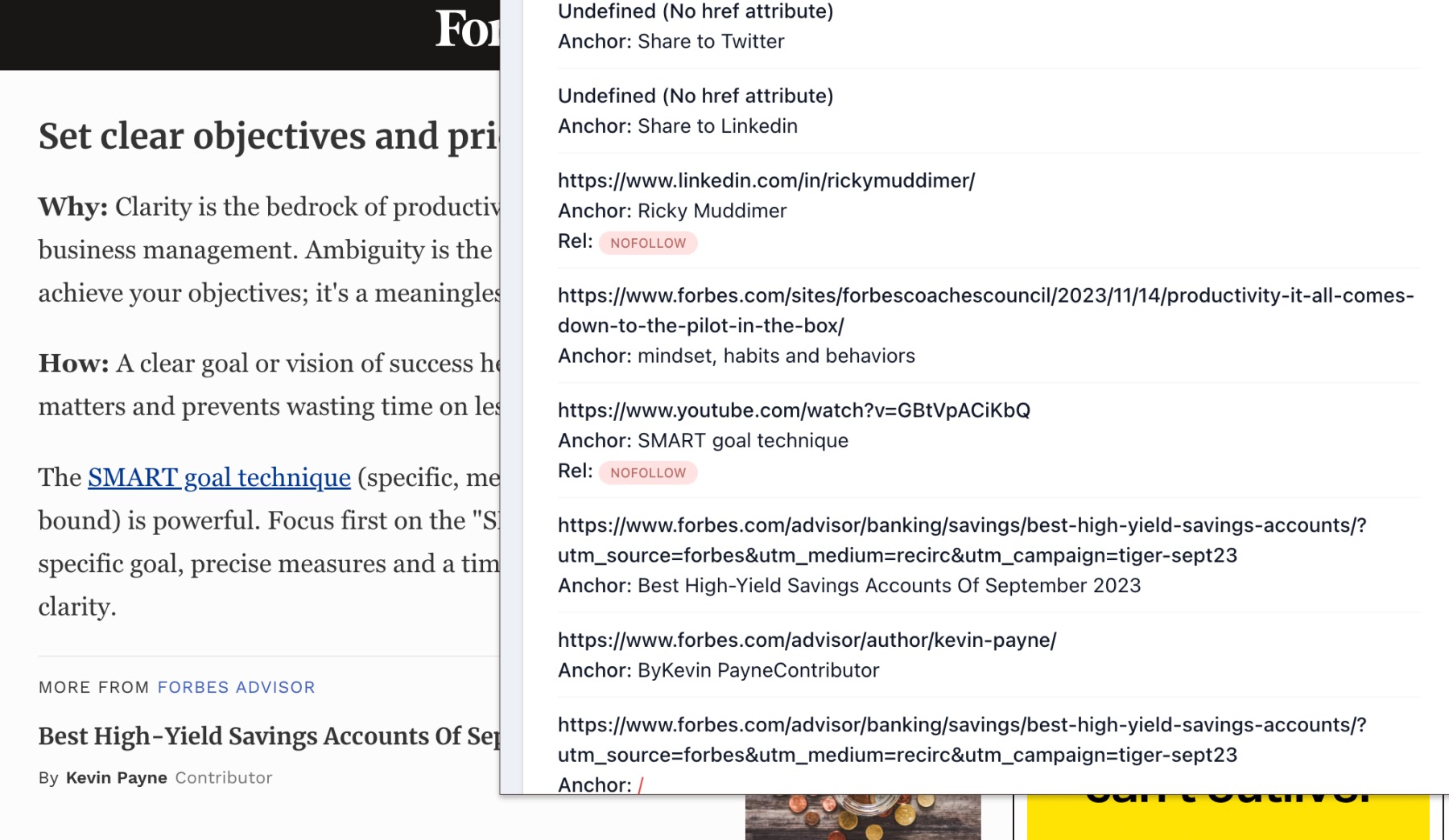If you’ve done any link building in your career, internal or external, you’re probably familiar with nofollow and dofollow links. If not, let’s start with some history and why it’s important to know the difference.
Google’s PageRank Algorithm
One of Google’s original core algorithms was their PageRank algorithm. The simplified explanation of how it worked is that a site’s value could be determined based on how many links it has and the quality of those links. The more links a page has, the more valuable it is, and the better it would rank.
The image below shows an example of the PageRank algorithm and how websites of varying authority levels can link to others and increase their authority. The percentage represents how authoritative each site is based on the authority of the sites linking to them.

As part of the PageRank algorithm, Google gave every page on the internet a PageRank score between 1 and 10. They even had a browser toolbar that showed the site’s score.

A higher PageRank score meant that the page was more powerful than pages with lower scores. That also meant that getting links from pages with higher PageRank scores would be more valuable.
Even though Google killed off the publicly available PageRank data in 2013, Google continued to use the data internally (though it’s uncertain if they still use it). Tools like Moz, SEMRush, and Ahrefs also calculate scores similar to the PageRank score. Each tool has its own way of calculating these metrics, but they’re basically scores between 1 and 100 that use a combination of link metrics much like Google did; the number of backlinks a page has and the quality of those backlinks.
The scores from these tools may not be official PageRank scores, but they can still give you some idea of the value of the site’s link profile and what Google’s scoring of a website is likely to be. Higher scores indicate how powerful a domain is – but a word of caution, these numbers can be manipulated by unethical website owners who are trying to auction off their sites or sell links and ad space at premium rates.
The Introduction of Nofollow
Since links were one of the biggest factors in Google’s ranking algorithm, link spam was rampant. Spammers put links all over the internet, and one area hit especially hard was blog comment sections.
All someone had to do was leave a URL in the comment “website” field or in the comment body, and they’d get a link. And many blogs auto-approved these links because they weren’t using spam-filtering software.
I still get spam like this every day.

Some of the more unscrupulous spammers would use automated software to leave link spam on thousands of websites at a time. So in 2005, Google introduced the nofollow attribute.
The nofollow attribute, also often referred to as the nofollow tag, tells search engines that you, as a site owner, do not endorse the link and that Google should not count it in their ranking analysis. It’s not a negative signal; it just tells the search engines to ignore that link.
Nofollow was designed specifically to address comment spam, but it has since evolved to address link spam in general. Today, it’s the default setting for comments on most content management systems such as WordPress, Squarespace, and Shopify. The attribute is also default on pretty much any website where someone can add a link to their own site, such as YouTube, Flickr, and Twitter.
Page Rank Sculpting
In the early 2000s, there was also another tactic SEOs used called PageRank sculpting.
As I mentioned earlier, Google had a PageRank score for every page on the internet. This score basically equated to the amount of authority a page had, and that authority would be distributed evenly to every link on the page. As a hypothetical example, if a page had a PageRank score of 10 and there were 10 links on the page, each link would get 1 point.

The SEO industry called the amount of authority a page could distribute its “link juice.”
To get the most out of your link juice, you could distribute PageRank to specific links of your choice on the page. So instead of each of the 10 links getting 1 point, you could filter it into 5 links, and get 2 points for each. PageRank didn’t flow through links with the nofollow attribute, so people would use this method for directing the flow of link juice throughout their site and pumping up their most important pages.
PageRank sculpting existed for years before nofollow was announced, but it didn’t become a well-known tactic until around 2008, when Rand Fishkin discussed it on SEOMoz.
Before nofollow, you could sculpt your PageRank by limiting the number of links you placed on a page or by wrapping a link in Javascript or Flash, which Google couldn’t read. Google never supported the idea of PageRank sculpting, but it didn’t become a problem for them until the nofollow attribute made it so easy for widespread adoption.
Because Google doesn’t like tactics that manipulate their search results and artificially improve rankings, they eventually put a stop to nofollow PageRank sculpting in 2009, as announced by Matt Cutts. Instead of the nofollow attribute preventing the flow of PageRank, as it had in the past, now PageRank would be distributed evenly to all links on the page, even links with nofollow, which would essentially waste PageRank instead of redirecting it.
The concept of PageRank Sculpting mostly died after that, but that doesn’t mean the tactic stopped working. It just doesn’t work with nofollow. In fact, it still works today and Cyrus Shepard even released research last year proving it.
Nofollow vs Dofollow Links

Now you know what nofollow is, but what is dofollow?
Dofollow is the industry term for any link that doesn’t have the rel=”nofollow” attribute on it. Dofollow links pass link equity to the site they point to. There is no such thing as a dofollow attribute. All links are “dofollow” until they have a “nofollow” attribute applied to them.
Here is what each looks like:
Nofollow Example
<a href=”https://www.yoursite.com/” rel=”nofollow”>Super Cool Company</a>
Dofollow Example
<a href=”https://www.yoursite.com/”>Super Cool Company</a>
Nofollow links do not pass link juice, are not counted in Google’s PageRank scores, and are ignored by search engines. Clearly, nofollow links are much less valuable than dofollow links, right? On its face, it seems that way, but there is much more to it.
Nofollow Links Can Send Traffic
Any link can send traffic to your site, and traffic is what leads to conversions. Would you rather have a nofollow link from The New York Times or a dofollow link from GenericPoorlyWrittenNewsSite.com? I would go for the site most likely to send me traffic every time. I’ve done a lot of link-building over the years, and the number one metric I start with is traffic.
Nofollow Links Can Result in Dofollow Links
A nofollow link can actually lead to a dofollow link. For example, let’s say your business is mentioned on a huge site like ScaryMommy.com – while that link might be nofollowed, think about the exposure that post will get. Thousands of people will see that article, and hundreds of websites will write about the same topic and mention your business. In many cases, those sites will not use the nofollow attribute. This exact scenario happened to a client of mine, and it sped up the growth of their business by years in only a matter of a few months.
Google Does Follow Nofollow Links Sometimes
In 2013, Google officially stated that “In general, we don’t follow them.” So while they usually didn’t follow nofollow links, there still might be exceptions. While never proven (at least as far as I know), some people believe that big sites like Wikipedia are one of those exceptions. It makes sense, too. These big sites have a lot of trust.
Nofollow Is Now a “Hint” and Used for Discovery
In late 2019, Google updated their documentation to say that nofollow would now be treated as a “hint” because, over time, they’ve learned that nofollow links contain information that helps them improve search, understand the content on the page, and find unnatural linking patterns. Shifting to a hint model meant that they would “no longer lose this important information, while still allowing site owners to indicate that some links shouldn’t be given the weight of a first-party endorsement.”
Google’s Martin Splitt also pointed out that while nofollow attributes would continue to be respected and would not be associated with the site they were placed on, the links would be used for discovery.
Nofollow Links Are Natural

You may not have been around long enough to experience the Google Penguin update, but it was one of the most significant updates the SEO industry has ever seen. This update was designed to demote sites that had artificially improved their rankings with unnatural links, such as links created by spam or that were purchased. It killed businesses overnight. There were so many businesses that were affected by this update that the agency I worked with launched a service specifically to help these websites recover. And it was not fun. These clients were frustrated, angry, and worried, and they wanted results NOW. It was also tedious analyzing millions of links, cleaning up link profiles, and submitting disavows to Google.
But the point I’m trying to make here is that one of the easiest ways (but only one of many) to identify an unnatural link profile is the ratio of nofollow to dofollow links. It’s completely normal for a site to have nofollow links. But if 99% of your links are dofollow, and you know that many of your links have been purchased or built unnaturally, you’re asking for trouble.
What is a Good Nofollow to Dofollow Ratio?
There really is no simple answer for this because the ratio changes for different industries, types of content, and even specific keywords. Christoph Cemper from LinkResearchTools showed examples of this in research he did a few years ago.
Also, in 2022, John Mueller from Google stated that there is no ideal ratio and that any ranking issues with the site “would not be due to the ratio of follow to nofollow links. That’s just not a thing.”
Aiming for a specific ratio is not a good metric to work towards because it doesn’t tell you anything about the quality of links you’re getting. But if you do want to use it for analysis, I recommend comparing your site to your competitors to get a better idea of what’s normal for your industry.
But to give you a number, I’ve looked at many sites over the years, and I typically see a ratio in the range of 70% dofollow links to 30% nofollow links, plus or minus 10% in either direction.
It’s important to understand that Google doesn’t usually penalize sites for bad backlinks anymore, but they will for the worst offenders. Instead, they mostly just ignore the links that they believe are unnatural or paid for.
But in my opinion, building an unnatural link profile could put your entire link profile in Google’s crosshairs; even good links. If Google thinks you’re doing something shady, their systems might assume that all of your links are unnatural.
Also, if you’re buying links and Google is simply ignoring them, that’s like throwing away money.
My suggestion is that you shouldn’t pass on a good link just because it’s nofollow.
Why You Should Use Dofollow On Your Own Website
Nofollow links are meant to indicate that you don’t endorse the page you’re linking to. They might also be used to prevent the flow of link juice when a link is sponsored or leads to an affiliate site (as per Google’s link spam guidelines).
Unfortunately, due to PageRank sculpting and fears of link penalties (linking out to bad sites can hurt your site, too), many sites have made it a default to use nofollow on all links, even truly useful links within editorial content.
In my opinion, we should give credit to the people who create useful content by supporting their work with a dofollow link. If a page is useful enough to share with your readers, it deserves any amount of link juice you can give it.
Case Studies
Don’t just take it from me. There are several great case studies showing the value of nofollow links.
- Case Study On Google’s Treatment Of 404 Pages, Links And Nofollow (Internet Marketing Ninjas, 2014)
- How Nofollow Links Increased Organic Traffic 288% in 1.5 Years (Teknicks, 2015)
- The Hidden Value of a Nofollow Link: Two Content Marketing Case Studies (Fractl, 2016)
- Nofollow Backlinks Are Passing the Link Juice and Here Is the Proof (SEMRush, 2017)
How to Identify Nofollow Links
Look, I know what it’s like to run a link-building campaign. I’ve been doing this for years while working at an agency. I know that dofollow links improve rankings. I also realize that in many cases, your client or boss will judge the performance of your efforts based on how many dofollow links you’ve earned.
Knowing this, some link-building campaigns require you to prioritize sites that provide dofollow links. If this is the type of link-building you’re doing, there are tools you can use to easily identify whether or not the site is using nofollow on its links, without having to look in the code.
One of my favorite browser tools is the Detailed SEO Extension from Glen Allsopp which has a tab that shows which links on a page are nofollow.

The SEO Pro Extension from Kristina Azarenko also has a similar feature. Both plugins also have an option to highlight nofollow links on the page, and they’re both free.
But I strongly recommend educating your clients about the value of nofollow links so that you get full credit for all of the links you earn.
Final Thoughts
Understanding the nuances between dofollow and nofollow links is important for anyone working in the field of digital marketing. While nofollow links were initially designed to combat spam and do not pass “link juice,” they still hold significant value by driving traffic and potentially leading to dofollow links. Dofollow links directly influence search rankings, but with the evolution of Google’s approach to nofollow links as “hints” and the importance of maintaining a natural link profile, nofollow links should be a part of your SEO strategy.
I hope this post was as interesting to read as it was for me to write. It was a lot of fun to put together because I started doing SEO in 2005 and actually got to live through all of the updates and announcements I’ve mentioned in this article! The SEO industry sure was wild.
Let me know your thoughts on nofollow and dofollow links. Do you have a different opinion or disagree with me? I’d love to hear what you think.

